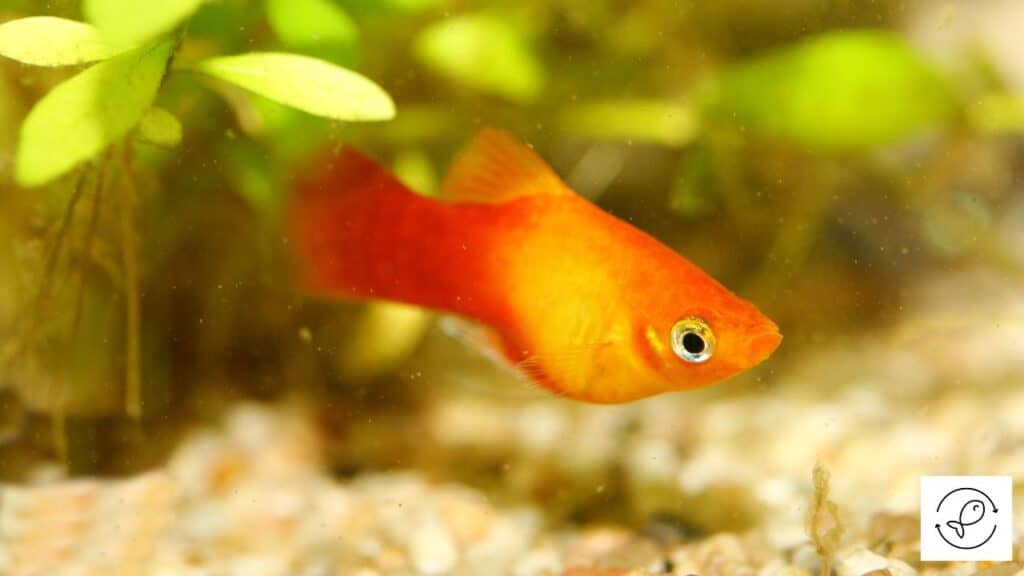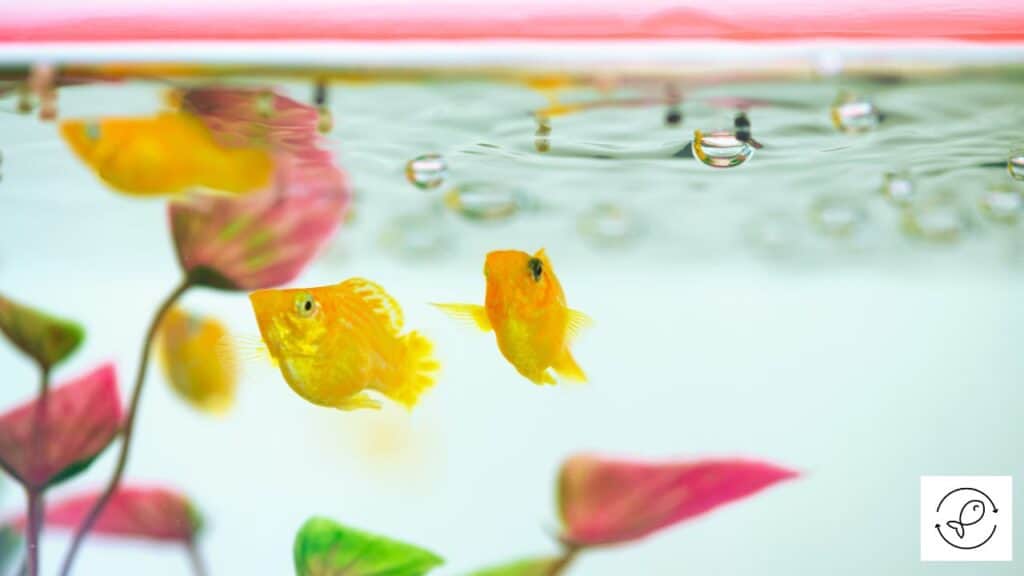Mollies and platies are popular for their bright colors and peaceful nature.
While they are both members of the same family, there are some differences between them.
So, what are the similarities and differences between the two?
Similarities Between Mollies and Platies
Mollies and platies are members of the Poeciliidae family, which includes many other live-bearing fish species.
They are both small and peaceful fish that are popular in the aquarium hobby.
Given below are the similarities between mollies and platies.
Reproduction Process
Mollies and platies are livebearers. They give birth to live fry instead of laying eggs.
Females of both fish species can store sperm for an extended period from a single mating.
Hence, they can produce multiple batches of fry every month, even without a male fish.
Another similarity between mollies and platies is that they both lack parental care tendencies.
Mollies and platies are known to eat their fry.
Hence, separating the fry from the parents is vital as soon as they are born.
Aquarium Set Up
Mollies and platies prefer a tank with plenty of plants, rocks, decorations, and other hiding places to feel secure.
They also need ample space to swim and explore the tank.
Both fish can tolerate a wide range of water parameters, but they prefer slightly alkaline water.
Water temperature between 72°F to 78°F (22.2°C to 25.5°C) is ideal for both fish.
They also need good filtration and regular water changes to keep the tank clean and free of harmful toxins.
Dietary Requirements
Platies and mollies are omnivores. They need a diverse and well-balanced diet of plant and animal matter for optimum growth.
Both fish thrive on flakes, pellets, live and frozen food, and vegetables in home aquariums.
However, many aquarists have found a subtle difference between the dietary needs of both these fish.
They have experienced that mollies have more protein requirements than platies.
However, there is no documentary evidence supporting it.
Hence, it’s best to provide a balanced diet consisting of plant and animal matter for both mollies and platies.
Hardiness
Mollies and platies are popular among aquarists for their hardiness and easy maintenance.
Both these fish can tolerate a wide range of water conditions and quickly adapt to various aquarium conditions.
Moreover, adult mollies and platies can survive for around 2 weeks without food.
However, it’s not recommended to keep them starving for that long.
Social Nature
Mollies and platies are known for their peaceful and social behavior.
They are both docile fish that can be kept with other peaceful species of similar size and temperament.
Mollies and platies are also known to form small shoals and swim around the aquarium in groups.
Both these fish are active, playful, and love to explore their environment.
Community Aquariums
Mollies and platies are favorites among aquarists for their stunning coloration, peaceful nature, and social activity.
So both these fish can be kept in a community aquarium with other peaceful species.
However, it’s crucial to maintain a balanced male-to-female ratio to avoid aggression.
Differences Between Mollies and Platies
Mollies and platies have a lot of similarities between them.
However, there are a few differences between these two fish species.
Given below are a few of the differences between mollies and platies.
Scientific Classification
Mollies and platies belong to the same Poeciliidae family. However, they belong to different genera.
Mollies belong to the Poecilia genus. On the other hand, platies belong to the Xiphophorus genus.
Their difference in genera makes them distinct from each other. They also can’t interbreed as they aren’t closely related.
Habitat

Mollies and platies share similar habitats. However, there is a subtle difference between the two fish.
Platies inhabit freshwater streams and rivers. They are native to the east coast of Central America and Southern Mexico.
On the other hand, mollies have a more diverse habitat. They are found in both fresh and brackish water habitats.
Appearance
Mollies and platies come in a variety of colors and patterns. So it’s difficult for a novice aquarist to differentiate between the two.
However, certain physical traits differentiate them from one another.
You can distinguish a molly from platy by observing the following physical characteristics:
- Color: Mollies come in various colors and patterns, while platies have more warm colors. Mollies come in shades of orange, black, green, and white. Conversely, platies have solid colors like red, orange, yellow, gold, and white. They also have spots on their bodies that mollies either lack or have very few.
- Body Shape: Mollies have longer and sleeker bodies. In comparison, the bodies of platies are rounder and comparatively shorter. Another difference is in their reproductive organs. Mollies have arrow-shaped curved gonopodia, whereas platies have long and straightened gonopodia with smooth rounded tips.
- Mouth Shape: Mollies and platies can be easily distinguished by their mouths. Mollies have a mouth that faces upwards. It helps them to feed on the surface of the water. On the other hand, platies have a downward-facing mouth. It helps them scrape algae from the surfaces in their natural environment.
- Fin and Tail: Mollies have long and more angular fins, particularly the dorsal fin that runs along their spine. In contrast, platies have smaller fins than mollies and often have a fan-shaped tail fin.
Size
Mollies and platies differ in size. Mollies are generally larger than platies.
The average size of mollies varies between 3 to 5 inches, depending on the species.
On the other hand, platies don’t grow as big as mollies. Adult platies typically measure around 2.8 inches.
Appetite
Mollies and platies vary in their appetite.
Mollies aren’t picky and don’t compete for food. Feeding twice a day is sufficient for the healthy development of mollies.
However, platies are voracious eaters. Although small, these little creatures are feisty and love to eat.
Platies need more food than mollies. So you need to feed them thrice a day for optimum growth.
Lifespan
Mollies have a little longer lifespan than platies.
Platies can live around 2 to 3 years in captivity. On the contrary, mollies can live up to 5 years in captivity.
However, both species can live up to 5 years in their natural environment due to more stable conditions and the inheritance of good genes.
Behavior
Mollies and platies are both docile and social fish. However, platies are more adventurous compared to mollies.
They are very curious to explore their environment and can attempt to jump out of the tank.
On the contrary, mollies are more laid back. They usually don’t jump out of the tank unless the living conditions aren’t conducive.
Can Mollies and Platies Be Kept Together?
Mollies and platies can be kept in the same tank since they are peaceful and friendly fish.
Both fish share similar water conditions.
The water needs to be warm with a temperature range of 72°F to 78°F (22.2°C to 25.5°C) for both the fish to thrive.
Adequate filtration is essential to ensure that the water remains clean and toxin-free.
Similarly, a heater can help to keep the water temperature stable and prevent any stress from sudden temperature changes.
Both these fish like dense vegetation. So, plants, rocks, caves, and other decorations can be added to provide hiding places for the fish.
A large tank is also necessary for mollies and platies to coexist peacefully in the same tank.
Since both these fish thrive in groups, a small group of at least 4 and a proper male-to-female ratio is recommended.
An appropriately sized tank will also ensure that both mollies and platies get enough place to claim their territories, swim freely, and explore the environment.
Lastly, adequate nutrition is essential for both species to thrive.
Feeding them various food items such as flakes, pellets, and live food will ensure their healthy development.
Takeaway
Mollies and platies are docile fish. They need a similar aquarium setup, and they share similar dietary requirements.
However, they differ in appearance, size, and appetite.
Despite the differences, you can house mollies and platies together in the same tank by maintaining the ideal water parameters and providing them enough space to swim.

